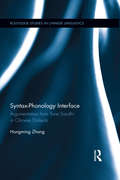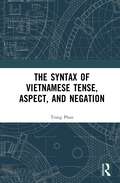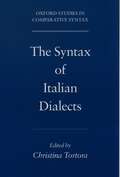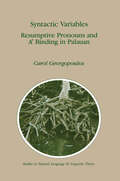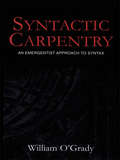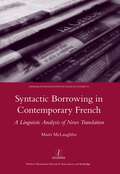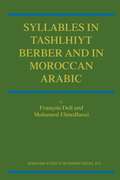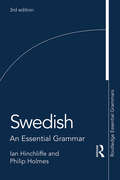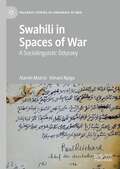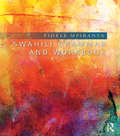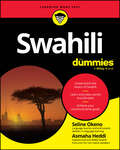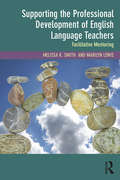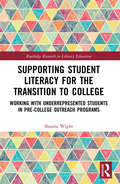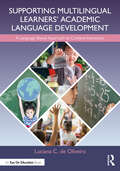- Table View
- List View
Syntax-Phonology Interface: Argumentation from Tone Sandhi in Chinese Dialects (Routledge Studies in Chinese Linguistics)
by Hongming ZhangThis book centers on theoretical issues of phonology-syntax interface based on tone sandhi in Chinese dialects. It uses patterns in tone sandhi to study how speech should be divided into domains of various sizes or levels. Tone sandhi refers to tonal changes that occur to a sequence of adjacent syllables or words. The size of this sequence (or the domain) is determined by various factors, in particular the syntactic structure of the words and the original tones of the words. Chinese dialects offer a rich body of data on tone sandhi, and hence great evidence for examining the phonology-syntax interface, and for examining the resulting levels of domains (the prosodic hierarchy). Syntax-Phonology Interface: Argumentation from Tone Sandhi in Chinese Dialects is an extremely valuable text for graduate students and scholars in the fields of linguistics and Chinese.
A Syntax-Oriented Translator
by Peter Zilahy IngermanA Syntax-Oriented Translator focuses on the field of programming and the characteristics and functions of compilers and translators.The book first offers information on the metasyntactic language and the details of a parsing processor. Discussions focus on processing, recovery, and output sections, detailed flow-chart of the parsing processor, parsing form of a grammar, canonical ordering, and the metasyntactic language in general. The text then elaborates on some extensions to the metasyntactic language and metasemantic and metapragmatic language, including punctuation marks and format control, metasemantic and metapragmatic functions, basic form of the construct, and substitution MSF. The publication examines the details of an unparsing processor, as well as lists used in unparsing, subroutines, and the unparsing processor itself. The book is a dependable source of information for home compiler-writers who are interested in the use of a syntax-oriented translator.
The Syntax of Vietnamese Tense, Aspect, and Negation
by Trang PhanThe Syntax of Vietnamese Tense, Aspect, and Negation investigates familiar grammatical phenomena including Tense, Aspect, and Negation in a theoretically understudied language, Vietnamese. The purpose of this book is to thoroughly examine how these categories are realised and how they interact with one another in Vietnamese in the spirit of Generative Grammar, in particular, the Cartographic approach to syntax and its most recently developed lexicalisation technique, Nanosyntax. It is concluded that despite lacking inflectional tense, Vietnamese does have syntactic tense, i.e., Vietnamese has those structural positions which are dedicated to Tense and Aspect. In fact, Tense and Aspect in Vietnamese are realised via a rigid fine-grained functional sequence which syntacticises subtle semantic distinctions both preverbally and post-verbally. There is a two-way complicated relationship between Negation and Aspect in Vietnamese, which can be explained in a principled way by taking into consideration how the internal syntax of the temporal, aspectual, and negative markers derives their clausal syntax. This book also discusses how Vietnamese Tense, Aspect, and Negation pattern with, and differ from, their counterparts in Western Indo-European languages, and how this study contributes to a better understanding of East and mainland Southeast Asian languages more generally, as well as of language universally. This book will be of interest to both undergraduate and postgraduate students of contemporary linguistics, and for scholars interested in contemporary approaches to Vietnamese linguistics, and Southeast Asian languages more generally.
The Syntax of Vietnamese Tense, Aspect, and Negation
by Trang PhanThe Syntax of Vietnamese Tense, Aspect, and Negation investigates familiar grammatical phenomena including Tense, Aspect, and Negation in a theoretically understudied language, Vietnamese. The purpose of this book is to thoroughly examine how these categories are realised and how they interact with one another in Vietnamese in the spirit of Generative Grammar, in particular, the Cartographic approach to syntax and its most recently developed lexicalisation technique, Nanosyntax. It is concluded that despite lacking inflectional tense, Vietnamese does have syntactic tense, i.e., Vietnamese has those structural positions which are dedicated to Tense and Aspect. In fact, Tense and Aspect in Vietnamese are realised via a rigid fine-grained functional sequence which syntacticises subtle semantic distinctions both preverbally and post-verbally. There is a two-way complicated relationship between Negation and Aspect in Vietnamese, which can be explained in a principled way by taking into consideration how the internal syntax of the temporal, aspectual, and negative markers derives their clausal syntax. This book also discusses how Vietnamese Tense, Aspect, and Negation pattern with, and differ from, their counterparts in Western Indo-European languages, and how this study contributes to a better understanding of East and mainland Southeast Asian languages more generally, as well as of language universally. This book will be of interest to both undergraduate and postgraduate students of contemporary linguistics, and for scholars interested in contemporary approaches to Vietnamese linguistics, and Southeast Asian languages more generally.
Syntactic Variables: Resumptive Pronouns and A′ Binding in Palauan (Studies in Natural Language and Linguistic Theory #24)
by C. GeorgopoulosThis book represents the culmination of an extended period of field work on the Palauan language, carried out while I was a graduate student at the University of California at San Diego. The book was born as a short term paper written in 1982; from a forgettable infancy, that paper grew and grew, reaching the age of majority in my dissertation at the end of 1985. Some of its offspring have gone off on their own, as indepen dent papers, as course materials, or as thoughts that have not yet com pletely materialized. Some have been disowned. The full adulthood of this study of Palauan is realized in the present book. Virtually every section of the dissertation has been rewritten, updated, or otherwise (I hope) improved. Where the dissertation was still struggling with various problems, the book has found solutions. The aim of the book remains, however, to give broad coverage of Palauan, with emphasis on A' binding, rather than to focus narrowly on a few highly specific theoretical issues. I hope to have achieved a balance between presenting the language clearly and nonprejudicially, and deal ing with various of its properties in current theoretical terms. If I have, the book should prove to be a resource for further typological study of the phenomena it describes.
Syntactic Carpentry: An Emergentist Approach to Syntax
by William O'GradySyntactic Carpentry: An Emergentist Approach to Syntax presents a groundbreaking approach to the study of sentence formation. Building on the emergentist thesis that the structure and use of language is shaped by more basic, non-linguistic forces—rather than by an innate Universal Grammar—William O'Grady shows how the defining properties of various core syntactic phenomena (phrase structure, co-reference, control, agreement, contraction, and extraction) follow from the operation of a linear, efficiency-driven processor. This in turn leads to a compelling new view of sentence formation that subsumes syntactic theory into the theory of sentence processing, eliminating grammar in the traditional sense from the study of the language faculty. With this text, O'Grady advances a growing body of literature on emergentist approaches to language, and situates this work in a broader picture that also includes attention to key issues in the study of language acquisition, psycholinguistics, and agrammaticism. This book constitutes essential reading for anyone interested in syntax and its place in the larger enterprise of cognitive science.
Syntactic Carpentry: An Emergentist Approach to Syntax
by William O'GradySyntactic Carpentry: An Emergentist Approach to Syntax presents a groundbreaking approach to the study of sentence formation. Building on the emergentist thesis that the structure and use of language is shaped by more basic, non-linguistic forces—rather than by an innate Universal Grammar—William O'Grady shows how the defining properties of various core syntactic phenomena (phrase structure, co-reference, control, agreement, contraction, and extraction) follow from the operation of a linear, efficiency-driven processor. This in turn leads to a compelling new view of sentence formation that subsumes syntactic theory into the theory of sentence processing, eliminating grammar in the traditional sense from the study of the language faculty. With this text, O'Grady advances a growing body of literature on emergentist approaches to language, and situates this work in a broader picture that also includes attention to key issues in the study of language acquisition, psycholinguistics, and agrammaticism. This book constitutes essential reading for anyone interested in syntax and its place in the larger enterprise of cognitive science.
Syntactic Borrowing in Contemporary French: A Linguistic Analysis of News Translation
by Mairi MaLaughlinIt is widely held that the large-scale translation of international news from English will lead to changes in French syntax. For the first time this assumption is put to the test using extensive fieldwork carried out in an international news agency and a corpus of translated news agency dispatches. The linguistic analysis of three syntactic structures in the translations is complemented by an investigation of the effects of a range of factors including, most notably, the speed at which the translation is carried out. The analysis sheds new light on the ways in which news translation could lead to syntactic borrowing in French, and by extension, in other languages.
Syntactic Borrowing in Contemporary French: A Linguistic Analysis of News Translation
by Mairi MaLaughlinIt is widely held that the large-scale translation of international news from English will lead to changes in French syntax. For the first time this assumption is put to the test using extensive fieldwork carried out in an international news agency and a corpus of translated news agency dispatches. The linguistic analysis of three syntactic structures in the translations is complemented by an investigation of the effects of a range of factors including, most notably, the speed at which the translation is carried out. The analysis sheds new light on the ways in which news translation could lead to syntactic borrowing in French, and by extension, in other languages.
Syllables In Tashlhiyt Berber And In Moroccan Arabic (International Handbooks of Linguistics #2)
by F. Dell M. ElmedlaouiThis book is intended primarily as an original contribution to the investi gation of the phonology of the two main languages spoken in Morocco. Its central topic is syllable structure. Our theoretical outlook is that of generative phonology. Most of the book deals with Tashlhiyt Berber. This language has a syllable structure with properties which are highly unusual, as seen from the vantage point of better-studied languages on which most theorizing about syllabification is based. On the one hand, complex consonant sequences are a common occurrence in the surface representations. On the other hand, syllable structure is very simple: only one distinctive feature bundle (phoneme) may occur in the onset, the nucleus or the coda. The way these two conflicting demands are reconciled is by allowing vowelless sylla bies . Any consonant may act as a syllable nucleus. When astring is syllabified, nuclear status is preferentially assigned to the segments with a higher degree of sonority than their neighbours. Consider for instance the expression below, which is a complete sentence meaning 'remove it (m) and eat it (m)': /kks=t t-ss-t=t/ [k. st. s . t:"] . k. k~t. t. s. . slt. The sentence must be pronounced voiceless throughout, as indicated by the IPA transcription between square brackets ; the syllabic parse given after the IPA transcription indicates that the sentence comprises four syllables (syllable nuclei are underlined). The differences between the dialects of Berber have to do primarily with the phonology and the lexicon.
Swedish: An Essential Grammar (Routledge Essential Grammars)
by Ian Hinchliffe Philip HolmesThis fully revised third edition of Swedish: An Essential Grammar incorporates changes proposed to Swedish grammar by Svenska Akademiens grammatik. Examples have been fully updated and the bibliography has been expanded. Swedish: An Essential Grammar provides a fresh and accessible description of the language. Explanations are free of jargon and emphasis has been placed on areas of Swedish that pose a particular challenge for English-speaking learners. The book offers: • a clear, accessible format; • authentic examples of language use, taken from a range of media; • clear, jargon-free explanations of grammar. Suitable for independent study or for class-based tuition, Swedish: An Essential Grammar continues to be an invaluable source to all learners looking to improve their knowledge of Swedish grammar.
Swahili in Spaces of War: A Sociolinguistic Odyssey (Palgrave Studies in Languages at War)
by Alamin Mazrui Kimani NjoguThis monograph examines the roles and functions of Swahili in war/conflict situations, and the impact of wars on the destiny of the language. Covering a period of over a century, the monograph explores this sociolinguistic theme in the context of six wars/conflicts: the Maji Maji resistance against German rule, the two World Wars, the anti-colonial resistance to British colonialism, the wars of the Great Lakes region, the cold wars, and the ongoing war against terrorism. In geographical focus, some of the war situations explored here are “local,” others are “transnational,” and others still rather “global” in scope and ramifications. In the final analysis, the monograph provides important snapshots of the conflict-based history of the Swahili language, demonstrating once again that language is a malleable tool that can be appropriated and galvanized to serve the interests of either party in a conflict and sometimes as a means of creating hegemonic and anti-hegemonic meanings.
Swahili Grammar and Workbook
by Fidèle MpiranyaSwahili Grammar and Workbook provides a practical and comprehensive companion to Swahili grammar, filling in gaps left by other textbooks. Presenting the essentials of Swahili grammar in a highly accessible fashion, it reduces complex language topics to helpful rules and mnemonic aids, enabling maximum grammar retention and accurate usage. Grammar points are followed by multiple examples and exercises, allowing students to consolidate and practice their learning. No prior knowledge of linguistic terminology is required. Key features include: Twenty five language notes covering key topics such as: personal pronouns; the Swahili noun class system; special class combinations; the imperative, the subjunctive, and the conditional moods; the use of comparatives; the use of monosyllabic verbs; the passive form and various other forms of verb extensions; the relative clause Clear, detailed and jargon-free grammatical explanations supported by an assortment of helpful diagrams, charts and tables and many relevant and up-to-date examples A wide range of communication-oriented exercises to reinforce learning and develop students’ ability to use Swahili actively Audio files to support pronunciation practice, clearly linked to relevant sections of the book and available for free download at http://www.routledge.com/books/details/9781138808263/ Four appendices, Swahili-English and English-Swahili vocabulary lists, a bibliography and an index presented at the back of the book for easy access to information. Written by a highly experienced instructor, Swahili Grammar and Workbook will be an essential resource for all students and teachers of Swahili. It is suitable for use both as a companion reference text in language courses and as a standalone text in independent grammar classes.
Swahili Grammar and Workbook
by Fidèle MpiranyaSwahili Grammar and Workbook provides a practical and comprehensive companion to Swahili grammar, filling in gaps left by other textbooks. Presenting the essentials of Swahili grammar in a highly accessible fashion, it reduces complex language topics to helpful rules and mnemonic aids, enabling maximum grammar retention and accurate usage. Grammar points are followed by multiple examples and exercises, allowing students to consolidate and practice their learning. No prior knowledge of linguistic terminology is required. Key features include: Twenty five language notes covering key topics such as: personal pronouns; the Swahili noun class system; special class combinations; the imperative, the subjunctive, and the conditional moods; the use of comparatives; the use of monosyllabic verbs; the passive form and various other forms of verb extensions; the relative clause Clear, detailed and jargon-free grammatical explanations supported by an assortment of helpful diagrams, charts and tables and many relevant and up-to-date examples A wide range of communication-oriented exercises to reinforce learning and develop students’ ability to use Swahili actively Audio files to support pronunciation practice, clearly linked to relevant sections of the book and available for free download at http://www.routledge.com/books/details/9781138808263/ Four appendices, Swahili-English and English-Swahili vocabulary lists, a bibliography and an index presented at the back of the book for easy access to information. Written by a highly experienced instructor, Swahili Grammar and Workbook will be an essential resource for all students and teachers of Swahili. It is suitable for use both as a companion reference text in language courses and as a standalone text in independent grammar classes.
Swahili For Dummies
by Seline Okeno Asmaha HeddiLearn the official language of Kenya and Tanzania Swahili For Dummies will teach you the basics of Swahili, so you can start conversing in Africa’s language of commerce. This book introduces you to the foundations of Swahili grammar and enables you to engage in basic conversations. With the simplified Dummies learning process, you’ll quickly get a grasp on the language, without complex terms and confusing explanations. You’ll also move through the book at a comfortable pace, so you’ll be familiar with what you’ve learned before moving on to more complex stuff. Focus on communication and interaction in everyday situations, so you can actually use the language you’re studying—right away. Understand the basics of Swahili Learn everyday words and phrases Gain the confidence to engage in conversations in Swahili Communicate while traveling and talk to Swahili-speaking family members Swahili For Dummies is for readers of all ages who want to learn the basics of Swahili in a no-stress, beginner-friendly way. Swahili teachers will also love sharing this practical approach with their students.
Swahili For Dummies
by Seline Okeno Asmaha HeddiLearn the official language of Kenya and Tanzania Swahili For Dummies will teach you the basics of Swahili, so you can start conversing in Africa’s language of commerce. This book introduces you to the foundations of Swahili grammar and enables you to engage in basic conversations. With the simplified Dummies learning process, you’ll quickly get a grasp on the language, without complex terms and confusing explanations. You’ll also move through the book at a comfortable pace, so you’ll be familiar with what you’ve learned before moving on to more complex stuff. Focus on communication and interaction in everyday situations, so you can actually use the language you’re studying—right away. Understand the basics of Swahili Learn everyday words and phrases Gain the confidence to engage in conversations in Swahili Communicate while traveling and talk to Swahili-speaking family members Swahili For Dummies is for readers of all ages who want to learn the basics of Swahili in a no-stress, beginner-friendly way. Swahili teachers will also love sharing this practical approach with their students.
Sustainability of Blended Language Learning Programs: Technology Integration in English for Academic Purposes (Routledge Focus on Applied Linguistics)
by Cynthia Nicholas Palikat Paul GrubaThis book focuses on the investigation of the sustainability of technology integration in the context of language programs and is based around an 18-month longitudinal study of a blended EAP (English for Academic Purposes) language program situated within a university pathways course. The integration of technology into language teaching and learning in academic English programs often demands substantial investment in professional development, curriculum change, and technological resources. Given the intense effort required, sustainability of such efforts has gained importance, focus, and urgency. Situated in the context of English for Academic Purposes (EAP) programs, this book frames, and investigates, the sustainability of technology integration through a series of case studies of specific technologies: tablet devices, a Learning Management System, and an interactive presentation app. The authors explore sustainable integration of technology; the use of argument-based approaches as a basis for research design; and participant ethnography as a form of data collection. The book concludes by looking at the implications of the research and proposes that change management concepts be applied to better introduce, implement, and most importantly, sustain change involving educational technology integration. The content will be of interest to scholars in TESOL and applied linguistics as well as professional language educators who will benefit from insights into sustaining technology integration in their programs.
Sustainability of Blended Language Learning Programs: Technology Integration in English for Academic Purposes (Routledge Focus on Applied Linguistics)
by Cynthia Nicholas Palikat Paul GrubaThis book focuses on the investigation of the sustainability of technology integration in the context of language programs and is based around an 18-month longitudinal study of a blended EAP (English for Academic Purposes) language program situated within a university pathways course. The integration of technology into language teaching and learning in academic English programs often demands substantial investment in professional development, curriculum change, and technological resources. Given the intense effort required, sustainability of such efforts has gained importance, focus, and urgency. Situated in the context of English for Academic Purposes (EAP) programs, this book frames, and investigates, the sustainability of technology integration through a series of case studies of specific technologies: tablet devices, a Learning Management System, and an interactive presentation app. The authors explore sustainable integration of technology; the use of argument-based approaches as a basis for research design; and participant ethnography as a form of data collection. The book concludes by looking at the implications of the research and proposes that change management concepts be applied to better introduce, implement, and most importantly, sustain change involving educational technology integration. The content will be of interest to scholars in TESOL and applied linguistics as well as professional language educators who will benefit from insights into sustaining technology integration in their programs.
Supporting the Professional Development of English Language Teachers: Facilitative Mentoring
by Melissa K. Smith Marilyn LewisApplying the principles of facilitative teaching to mentorship, this book brings together well-established knowledge about mentoring with the experiences and ideas of mentors in the field to advance and support the professional development of language teachers. Recognizing the impact of globalization and technology, Smith and Lewis identify processes and pathways for mentors to develop multi-layered skills for working with teachers in both their own and cross-cultural contexts, and in face-to-face and virtual settings. Grounded in theory, this innovative approach is illustrated with authentic experiences, and ready to be applied by readers in their specific settings around the world. With an interactive design that encourages participation and practice, each chapter includes vignettes, reflections, and challenging scenarios from mentors in training. Self-reflection and task sections at the end of each chapter engage the reader in combining theory with practice. Sample materials such as mentor-mentee contracts, work plans, journal templates, discussion suggestions (face-to-face or online), and observation forms deepen understanding and enable mentors to adapt or create their own materials. This practical and context-adaptable guide is accessible to mentors at any career stage, for use in personal professional development, or as part of mentor training sessions.
Supporting the Professional Development of English Language Teachers: Facilitative Mentoring
by Melissa K. Smith Marilyn LewisApplying the principles of facilitative teaching to mentorship, this book brings together well-established knowledge about mentoring with the experiences and ideas of mentors in the field to advance and support the professional development of language teachers. Recognizing the impact of globalization and technology, Smith and Lewis identify processes and pathways for mentors to develop multi-layered skills for working with teachers in both their own and cross-cultural contexts, and in face-to-face and virtual settings. Grounded in theory, this innovative approach is illustrated with authentic experiences, and ready to be applied by readers in their specific settings around the world. With an interactive design that encourages participation and practice, each chapter includes vignettes, reflections, and challenging scenarios from mentors in training. Self-reflection and task sections at the end of each chapter engage the reader in combining theory with practice. Sample materials such as mentor-mentee contracts, work plans, journal templates, discussion suggestions (face-to-face or online), and observation forms deepen understanding and enable mentors to adapt or create their own materials. This practical and context-adaptable guide is accessible to mentors at any career stage, for use in personal professional development, or as part of mentor training sessions.
Supporting Student Literacy for the Transition to College: Working with Underrepresented Students in Pre-College Outreach Programs (Routledge Research in Literacy Education)
by Shauna WightFocusing on the needs and experiences of underrepresented students in the US, this text explores how pre-college outreach programs can effectively support the development of students’ writing skills in preparation for the transition from high school to college. Synthesizing data from a longitudinal study focusing on multilingual, low-income, and first-generation students, this volume provides in-depth exploration of the strategies and resources used in a pre-college literacy program in the US. Grounded in an expansive, qualitative study, chapters reveal how outreach practices can encourage student-led research, writing, confidence, and collaboration. More broadly, programs are shown to help tackle issues of inequality, increase college readiness, and reduce difficulties with writing which can restrict minority students’ access to higher education and their longer-term college attainment. This text will benefit researchers, academics, and educators with an interest in English and literacy studies, multicultural education, and pre-college writing instruction. Those interested in bilingualism, translingualism, writing studies, English as a second language (ESL), and applied linguistics will also benefit from the volume.
Supporting Student Literacy for the Transition to College: Working with Underrepresented Students in Pre-College Outreach Programs (Routledge Research in Literacy Education)
by Shauna WightFocusing on the needs and experiences of underrepresented students in the US, this text explores how pre-college outreach programs can effectively support the development of students’ writing skills in preparation for the transition from high school to college. Synthesizing data from a longitudinal study focusing on multilingual, low-income, and first-generation students, this volume provides in-depth exploration of the strategies and resources used in a pre-college literacy program in the US. Grounded in an expansive, qualitative study, chapters reveal how outreach practices can encourage student-led research, writing, confidence, and collaboration. More broadly, programs are shown to help tackle issues of inequality, increase college readiness, and reduce difficulties with writing which can restrict minority students’ access to higher education and their longer-term college attainment. This text will benefit researchers, academics, and educators with an interest in English and literacy studies, multicultural education, and pre-college writing instruction. Those interested in bilingualism, translingualism, writing studies, English as a second language (ESL), and applied linguistics will also benefit from the volume.
Supporting Multilingual Learners’ Academic Language Development: A Language-Based Approach to Content Instruction
by Luciana C. de OliveiraA practical and comprehensive resource, Supporting Multilingual Learners’ Academic Language Development: A Language-Based Approach to Content Instruction introduces an accessible language-based approach to teaching academic language to multilingual learners across the content areas. Luciana C. de Oliveira provides elementary school teachers with everything they need to know to successfully teach grade-level content to multilingual learners. Chapters are organized by subject, addressing the specific language demands of teaching English language arts, social studies, mathematics, and science. Each chapter features examples of implementation in grades K-5, practical strategies, and a wealth of tables, figures, and other resources. The Language-Based Approach to Content Instruction (LACI) in this book provides teachers with a ready-to-use framework of six scaffolding elements that serves as a guide to enable multilingual learners to meet the grade-level standard of their peers without simplification. Aligned with WIDA and CCSS standards, this resource provides the tools and methods teachers need to support multilingual learners’ academic language development in the content area classroom.
